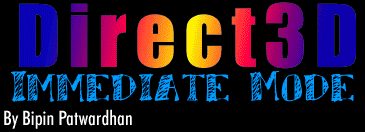|
Summary
Appendix A
The complete source of the sample application is presented here.
Popup: Full Source
To summarise, we can say that immediate mode is a lower-level interface to providing 3D capabilities in an application. Even though it is a low-level interface, its support is well defined. An advantage of using the immediate mode is that even though it does not provide a built-in geometry engine, we can use custom algorithms, to make the application perform better. The only possible limitation of writing a custom application is that the application may have a performance hit in case the engine is not written properly and efficiently.
After covering the different features of the immediate mode, followed by a sample application, we covered some of the objects provided by the immediate mode, which can be used by an application.
References
- 1
-
Mehmat Adalier.
Direct3D Immediate Mode Part I.
Intel, Developers Relations Group, July 1997.
XDC, July 97, Session 124.
- 2
-
Microsoft Corporation.
DirectX SDK (ver 3.0, 5.0) Reference.
Microsoft Corporation, 1996-97.
- 3
-
Microsoft Corporation.
Direct3D Reference Manual.
Microsoft Corporation, 1997.
Visual Studio Help.
- 4
-
Microsoft Corporation.
Direct3D Specification : DrawPrimitive API Extensions,
ver 0.7.
Microsoft Corporation Web Page (www.microsoft.com/directx), 1 Feb
1997.
- 5
-
DrawPrimitive White Paper.
DirectX Developer Pages
(www.geocities.com/SiliconValley/Way/8390/draprim.html), 1997.
- 6
-
Mark Feldman.
DirectX 5.0 DrawPrimitive Tutorial.
DirectX Developer Pages
(www.geocities.com/SiliconValley/Way/8390/drawprim.html), 1997.
- 7
-
Foley and Van Damm.
Introduction to Computer Graphics.
Addison Wesley, 1994.
- 8
-
Donald Hearn and Pauline Baker.
Computer Graphics.
Prentice Hall of India, 2nd edition, 1994.
- 9
-
Hillarie Klempner.
Direct3D Immediate Mode Part II.
Intel, Developers Relations Group, July 1997.
XDC, July 97, Session 224.
- 10
-
Bipin Patwardhan.
Direct3D Retained Mode.
National Centre for Software Technology, Mumbai, India, Aug-Sep 1997.
Intel Developers Conference, Aug-Sep 97.
- 11
-
Bipin Patwardhan.
Overview of Direct3D.
National Centre for Software Technology, Mumbai, India, Aug-Sep 1997.
Intel Developers Conference, Aug-Sep 97.
- 12
-
Charles Petzold.
Windows 95 Programming.
Microsoft Press, 1st edition, 1996.
- 13
-
Jeff Prosise.
Windows 95 Programming Using MFC.
Microsoft Press, 1st edition, 1997.
- 14
-
David Rogers.
Procedural Elements for Computer Graphics.
McGraw-Hill Book Company, 1st edition, 1985.
- 15
-
David Rogers.
Mathematical Elements for Computer Graphics.
McGraw-Hill Book Company, 2nd edition, 1990.
- 16
-
Alan Watt.
Fundamentals of Three Dimensional Computer Graphics.
Addison Wesley, 1989.
- 17
-
Alan Watt.
3D Computer Graphics.
Addison Wesley, 2nd edition, 1993.
Bipin Patwardhan
Fri Jan 2 14:54:08 GMT 1998
|
